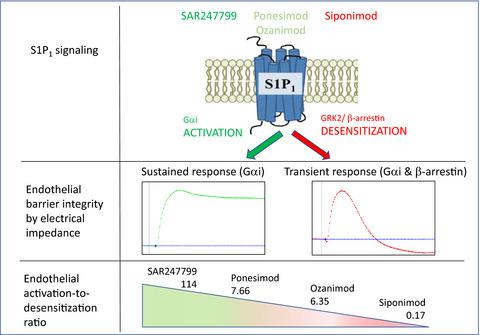当前位置:
X-MOL 学术
›
FEBS Open Bio
›
论文详情
Our official English website, www.x-mol.net, welcomes your
feedback! (Note: you will need to create a separate account there.)
A label-free impedance assay in endothelial cells differentiates the activation and desensitization properties of clinical S1P1 agonists.
FEBS Open Bio ( IF 2.8 ) Pub Date : 2020-08-18 , DOI: 10.1002/2211-5463.12951 Patrick Grailhe 1 , Asma Boutarfa-Madec 1 , Philippe Beauverger 1 , Philip Janiak 1 , Ashfaq A Parkar 2
FEBS Open Bio ( IF 2.8 ) Pub Date : 2020-08-18 , DOI: 10.1002/2211-5463.12951 Patrick Grailhe 1 , Asma Boutarfa-Madec 1 , Philippe Beauverger 1 , Philip Janiak 1 , Ashfaq A Parkar 2
Affiliation

|
Sphingosine‐1 phosphate receptor‐1 (S1P1) activation maintains endothelial barrier integrity, whereas S1P1 desensitization induces peripheral blood lymphopenia. The latter is exploited in the approval and/or late‐stage development of receptor‐desensitizing agents targeting the S1P1 receptor in multiple sclerosis, such as siponimod, ozanimod, and ponesimod. SAR247799 is a recently described G protein‐biased S1P1 agonist that activates S1P1 without desensitization and thus has endothelial‐protective properties in patients without reducing lymphocytes. As SAR247799 demonstrated endothelial‐protective effects at sub‐lymphocyte‐reducing doses, the possibility exists that other S1P1 modulators could also exhibit endothelial‐protective properties at lower doses. To explore this possibility, we sought to quantitatively compare the biased properties of SAR247799 with the most advanced clinical molecules targeting S1P1. In this study, we define the β‐arrestin pathway component of the impedance profile following S1P1 activation in a human umbilical vein endothelial cell line (HUVEC) and report quantitative indices of the S1P1 activation‐to‐desensitization ratio of various clinical molecules. In a label‐free impedance assay assessing endothelial barrier integrity and disruption, the mean estimates (95% confidence interval) of the activation‐to‐desensitization ratios of SAR247799, ponesimod, ozanimod, and siponimod were 114 (91.1–143), 7.66 (3.41–17.2), 6.35 (3.21–12.5), and 0.170 (0.0523–0.555), respectively. Thus, we show that SAR247799 is the most G protein‐biased S1P1 agonist currently characterized. This rank order of bias among the most clinically advanced S1P1 modulators provides a new perspective on the relative potential of these clinical molecules for improving endothelial function in patients in relation to their lymphocyte‐reducing (desensitization) properties.
中文翻译:

内皮细胞中的无标记阻抗测定可区分临床 S1P1 激动剂的激活和脱敏特性。
鞘氨醇-1 磷酸受体-1 (S1P 1 ) 激活可维持内皮屏障完整性,而 S1P 1脱敏会导致外周血淋巴细胞减少。后者用于针对多发性硬化症中 S1P 1受体的受体脱敏剂的批准和/或后期开发,例如西尼莫德、奥扎尼莫德和波内西莫德。 SAR247799 是最近描述的一种 G 蛋白偏向 S1P 1激动剂,可激活 S1P 1而无需脱敏,因此在不减少淋巴细胞的情况下对患者具有内皮保护特性。由于 SAR247799 在亚淋巴细胞减少剂量下表现出内皮保护作用,因此其他 S1P 1调节剂也有可能在较低剂量下表现出内皮保护特性。为了探索这种可能性,我们试图定量比较 SAR247799 与针对 S1P 1 的最先进临床分子的偏差特性。在本研究中,我们定义了人脐静脉内皮细胞系 (HUVEC) 中 S1P 1激活后阻抗谱的 β-arrestin 通路成分,并报告了各种临床分子的 S1P 1激活与脱敏比率的定量指标。在评估内皮屏障完整性和破坏的无标记阻抗测定中,SAR247799、ponesimod、ozanimod 和 siponimod 的激活与脱敏比率的平均估计值(95% 置信区间)分别为 114 (91.1–143)、7.66 (分别为 3.41–17.2)、6.35 (3.21–12.5) 和 0.170 (0.0523–0.555)。因此,我们表明 SAR247799 是目前表征的最偏向 G 蛋白的 S1P 1激动剂。 临床上最先进的 S1P 1调节剂之间的这种偏倚顺序为这些临床分子在改善患者内皮功能(与其淋巴细胞减少(脱敏)特性相关)方面的相对潜力提供了新的视角。
更新日期:2020-10-02
中文翻译:

内皮细胞中的无标记阻抗测定可区分临床 S1P1 激动剂的激活和脱敏特性。
鞘氨醇-1 磷酸受体-1 (S1P 1 ) 激活可维持内皮屏障完整性,而 S1P 1脱敏会导致外周血淋巴细胞减少。后者用于针对多发性硬化症中 S1P 1受体的受体脱敏剂的批准和/或后期开发,例如西尼莫德、奥扎尼莫德和波内西莫德。 SAR247799 是最近描述的一种 G 蛋白偏向 S1P 1激动剂,可激活 S1P 1而无需脱敏,因此在不减少淋巴细胞的情况下对患者具有内皮保护特性。由于 SAR247799 在亚淋巴细胞减少剂量下表现出内皮保护作用,因此其他 S1P 1调节剂也有可能在较低剂量下表现出内皮保护特性。为了探索这种可能性,我们试图定量比较 SAR247799 与针对 S1P 1 的最先进临床分子的偏差特性。在本研究中,我们定义了人脐静脉内皮细胞系 (HUVEC) 中 S1P 1激活后阻抗谱的 β-arrestin 通路成分,并报告了各种临床分子的 S1P 1激活与脱敏比率的定量指标。在评估内皮屏障完整性和破坏的无标记阻抗测定中,SAR247799、ponesimod、ozanimod 和 siponimod 的激活与脱敏比率的平均估计值(95% 置信区间)分别为 114 (91.1–143)、7.66 (分别为 3.41–17.2)、6.35 (3.21–12.5) 和 0.170 (0.0523–0.555)。因此,我们表明 SAR247799 是目前表征的最偏向 G 蛋白的 S1P 1激动剂。 临床上最先进的 S1P 1调节剂之间的这种偏倚顺序为这些临床分子在改善患者内皮功能(与其淋巴细胞减少(脱敏)特性相关)方面的相对潜力提供了新的视角。











































 京公网安备 11010802027423号
京公网安备 11010802027423号